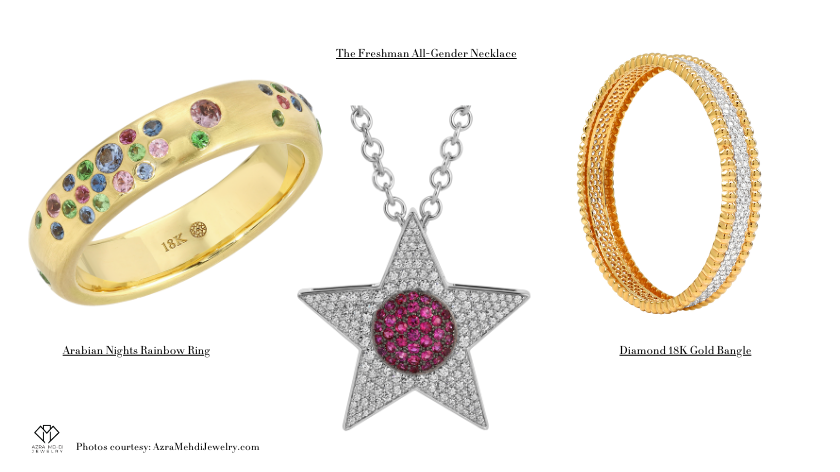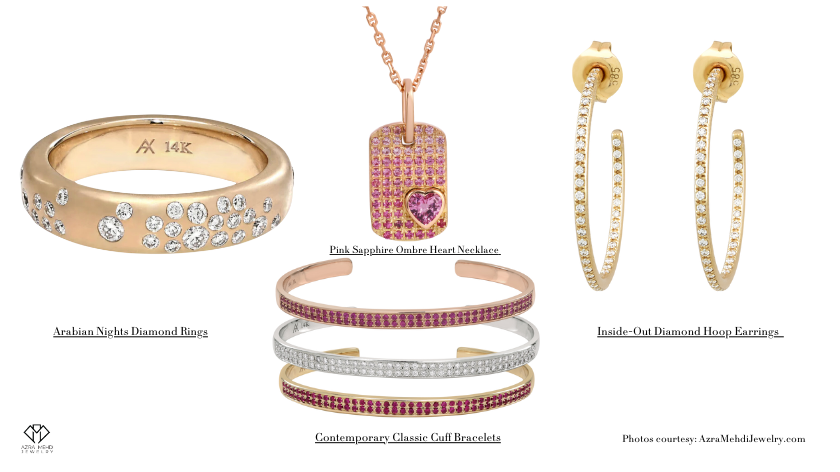
When it comes to buying gold jewelry, it's not just about choosing a design that catches your eye. The color and karat of gold can significantly influence both its appearance and durability, affecting how often we decide to wear it. This guide by Azra Mehdi Jewelry will help you make an informed choice to ensure that the gold jewelry you are buying not only looks beautiful but also suits you and your lifestyle. At the end of the day, buying gold jewelry is a very personal decision and all about “YOU.” There is no formula. You can and should “Express Yourself, Your Way!
Understanding Gold Karat
Gold, known as Aurum in Latin, means “Glowing Dawn,” a reference to the golden glow from pure gold. When buying gold jewelry, you should look for the “K” or “karat” mark, which is the measure of purity of the gold. This “K” mark will tell you the gold content in the piece of jewelry you are purchasing.
24K Gold (100% pure gold): This is pure gold and sometimes has the mark “999.” Pure gold is soft and prone to scratching, making it less ideal for jewelry that's worn daily.
22K Gold (91.6% gold): You can recognize this gold by the stamp “22K’ or “916.” 22K gold is best used for plain solid gold jewelry, but not for setting diamonds or other gemstones because although not as soft as 24K Gold (due to the presence of alloy mixture), the gemstones are likely to fall off with relatively minor bumps. There is also the danger that the soft 22K soft prong holding your precious stones may get bent and allow your gemstone to slip out. As with 24K gold, another problem with 22k gold is that it scratches easily, making your jewelry look old and used, even when it is relatively new.

18K Gold (75% gold): You can recognize this gold by the “18K” or "750" stamp. 18K gold is commonly used for fine jewelry due to its hardness. Diamonds and other precious stones set in 18K gold are pretty sturdy and have a smaller chance of falling out of their settings. 18K gold is more yellow in color due to the higher concentration of pure gold. A higher resale value is an added advantage of buying 18K gold jewelry. Included in our AMJ Bespoke Collection, we have a number of products in 18K gold, like the Diamond 18K Gold Bangle, The Freshman All-Gender Necklace, the Arabian Nights Cuff Bracelet, and Figure 8 Diamond Drop Earrings.
14K Gold (58.5% Gold): This gold is recognized by the “14K” or “585” stamp. 14K gold strikes a balance between purity and strength. Due to its hardness, it is more resistant to wear and tear from everyday use and thus great for people with busy lifestyles. 14K gold is suited for earrings, engagement rings, bracelets, and other items that you might wear more frequently. Moreover, its color makes it more suitable for different skin tones. This is the reason most of Azra Mehdi Jewelry is made from 14K solid gold, not hollowed out or plated gold. Although not exhaustive, some examples include, the Pink Sapphire Ombré Heart Necklace, the Contemporary Cuff Bracelets, all the hoop earrings in the A-Collection, the Arabian Nights Rings.
10K Gold (41.7% gold): This gold is recognized by the 10K stamp. It has the highest durability but a lighter gold color and is suitable for high-wear items like wedding bands. The disadvantage of 10K gold is diminished resale value.
Generally, gold jewelry out of 12K, 10K or 9K gold is not considered “fine jewelry” and partly because of diminished resale value. Because the Azra Mehdi Jewelry brand values gold jewelry as an “Investment for the Future,” we do not use less than 14K solid gold in any of our jewelry creations, no matter how dainty the piece. We view gold jewelry not as a mere accessory, but as an investment. By choosing high-quality materials and intricate craftsmanship, the AMJ brand ensures that each piece from our collection not only retains its value but appreciates over time, becoming a treasured heirloom for generations to come.
Choosing the Right Color in Gold Jewelry
Pure gold comes in a deep yellowish-reddish hue, but as noted above, it is not used to make gold jewelry because it is very soft and too fragile for everyday use. Pure gold is mixed or alloyed with other metals such as silver, copper, nickel, and zinc to improve its strength and resilience.
Gold jewelry is generally available in Yellow, White, or Rose (or Pink) gold.
Yellow Gold: Timeless and traditional, yellow gold complements warmer skin tones beautifully. Made by mixing pure gold with an alloy of mostly silver and copper. It is the purest of colors because of its closeness to pure gold. A higher percentage of copper is used for a darker yellow shade.
White Gold: Created by alloying gold with at least one white metal like palladium, silver or nickel, it has a modern appeal and suits cooler skin tones. Nickel is being used less frequently because a high percentage of people are allergic to nickel, which can cause rashes or turn your skin green. White gold is generally more durable and scratch-resistant than yellow gold. Initially, white gold was a mixture of palladium and yellow gold. But nowadays, it is most often created by combining yellow gold with alloys like zinc, copper, and a platinum compound. Rhodium plating is usually added to remove any trace of yellow gold that may still shine through, so it looks more white. Although this plating may need to be replaced every few years, it is an affordable fix.
Rose or Pink Gold: Rose Gold is alloyed with gold, copper, and silver. With its romantic pink hue, thanks to the addition of copper, rose gold is a unique choice that has gained popularity for its warm, flattering effect on most skin tones. The more copper added to the mix, the deeper and redder the rose gold hue. Rose gold is more affordable than the other gold colors because it uses the inexpensive copper for its rose color. Due to its copper content, rose gold is also more durable than yellow or white gold. Peach Gold is obtained by mixing gold with just copper.
Unusual Gold Hues to Know
Silver, copper, zinc, palladium are classic gold alloys. Use of non-traditional gold alloys or "low density" metals like cobalt, aluminum, potassium, and “high density” metals like silver, tin, lead results in unusual hues. Alloys of the most unusual hues are called intermetallic compounds. Intermetallic compounds include blue gold and its hues, ranging from light blue to saturated violet. A significant problem is that these metals have low plasticity and high fragility and thus can dent or crack more easily.

Green gold (or Electrum): Created by a precise process of alloying, where gold is mixed with silver in specific proportions to achieve the desired shade of green. The standard formula for creating green gold typically involves combining 75% gold with 25% silver. However, variations in these proportions can lead to different shades of green, ranging from a light, subtle green to a deeper, more distinct color.
Blue gold is a gold alloy having 46 per cent 11-karat gold and 54 per cent indium — AuIn2. The blue intermetallic compound has a high degree of brittleness. AuGa2, a gold-gallium compound with a light bluish hue and 58 per cent 14K gold, has a lighter bluish hue and a higher density than AuIn2, which makes it more durable.Blue gold is primarily utilized as trim in jewelry and watches because of its fragility.
Purple gold (also called amethyst or violet gold) is an alloy of gold and aluminum, where the gold content is around 79% and can therefore be referred to as 18 karat gold. Purple gold is more brittle than other gold alloys and can shatter easily. Oddly enough, it is usually machined and faceted to be used as a "gem" in conventional jewelry rather than by itself. Due to its brittleness and the challenges associated with working with it, purple gold is not typically used for items that require durability, like rings or bracelets that are subject to daily wear and tear. Instead, it's often used in combination with other metals as accents or inlays in jewelry, offering a striking contrast and adding a touch of unique elegance to the piece.
Black gold refers to gold that has undergone surface treatment or oxidation to give it a black appearance.The base metal is still gold, but the surface has been altered to achieve the black coloration, which can be achieved through several different processes like ruthenium or rhodium plating, controlled oxidation or laser treatments each resulting in a durable and striking black surface. Gold–cobalt–chromium alloy (75% gold, 15% cobalt, 10% chromium) yields a surface oxide that's olive-tinted.
Choosing the Right Gold Color for Your Skin Tone.
That is the million-dollar question. First and foremost, you should always choose jewelry that you will LOVE wearing. Sadly though, people often buy a brand without considering whether the particular piece of jewelry or the brand aesthetic compliments them merely because they have seen it look good on someone else. Wouldn’t you rather know what metal color suits your skin best, both aesthetically and functionally? Because jewelry often rests on skin (although not always), the contrast of the metal against your skin is apparent. Understanding which metal compliments your skin tone is, therefore, critical.
Skin tone is not the same as your skin color. Skin tone or under-color is unchanging and related to ethnicity and biological composition (relative ratios of melanin and pigment), while skin color may go from pale to tan depending on exposure to the environment.
Skin tones vary from warm to neutral to cool.
The easiest way to figure out your skin tone is by looking at the veins on your wrist in natural light.
- If they look blue or purple, you probably have a cool tone, while greenish veins indicate a warm skin tone.
- If it’s hard to determine or your veins seem to be a mix of blue and green, you might have a neutral skin tone.
Your skin’s reaction to the sun can also give clues:
- If you tan easily and seldom burn, you might have a warm or neutral skin tone.
- If you burn easily or turn pink before tanning, you likely have a cool skin tone.
White gold, platinum and silver compliments people with cool skin tones, while people with warm skin tones look good in yellow and rose gold, copper and brass jewelry. If you have a neutral skin tone, you’re lucky because you look good in both white metals and yellow metals.
Making The Best Selection For You
When choosing gold jewelry, consider your lifestyle and how often you plan to wear the piece. For people with busy lifestyles, 14K gold in a color that compliments your skin tone can be both practical for everyday wear and aesthetically pleasing. For meaningful pieces, 18K gold offers a richer hue and luxurious feel and can still accommodate daily wear.
Also think about the maintenance. Higher karat gold will require more care to maintain its appearance, while lower karat pieces are more resilient to wear and tear.
In summary, selecting the perfect gold jewelry is about more than just the popular brand or design. By considering the karat and color, you ensure your jewelry not only looks stunning but also fits perfectly into your lifestyle, maximizing wearability and enjoyment. Remember, the best choice is one that reflects your personal style while also meeting your practical needs. Happy jewelry hunting!
Azra Mehdi Jewelry- In the News

JCKOnline.com

JCK Online Magazine

Women's Education










